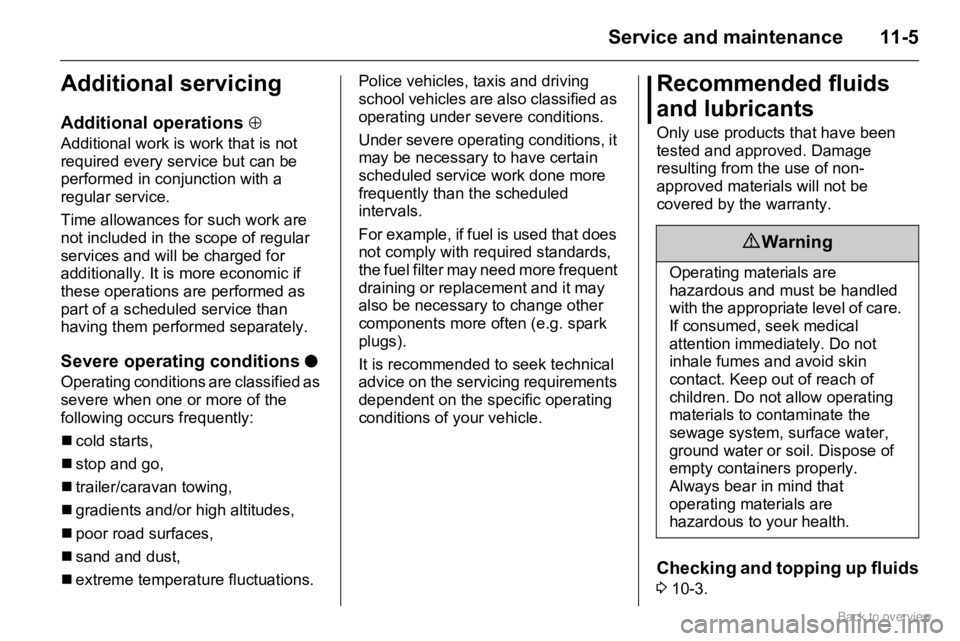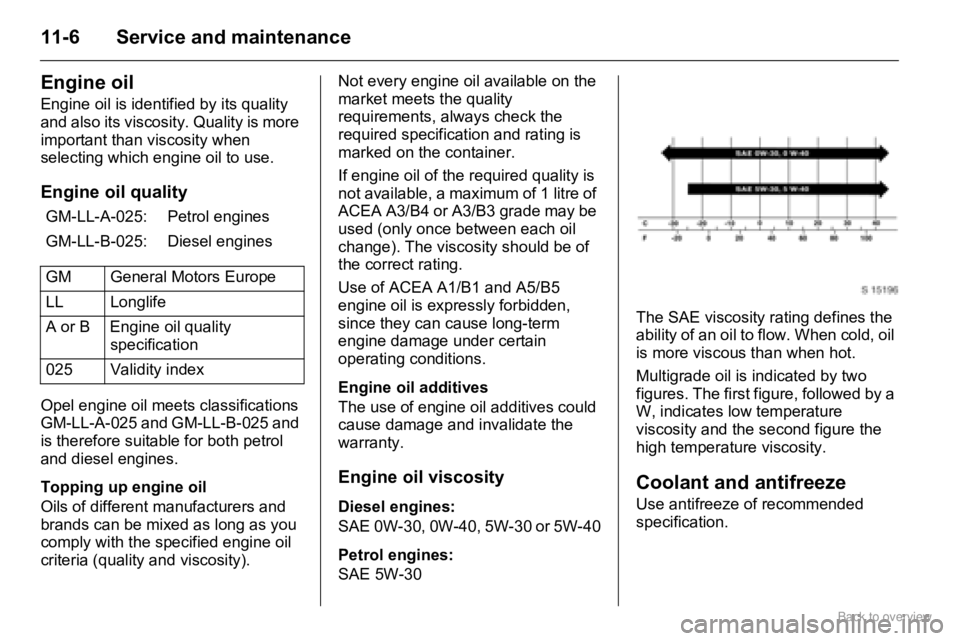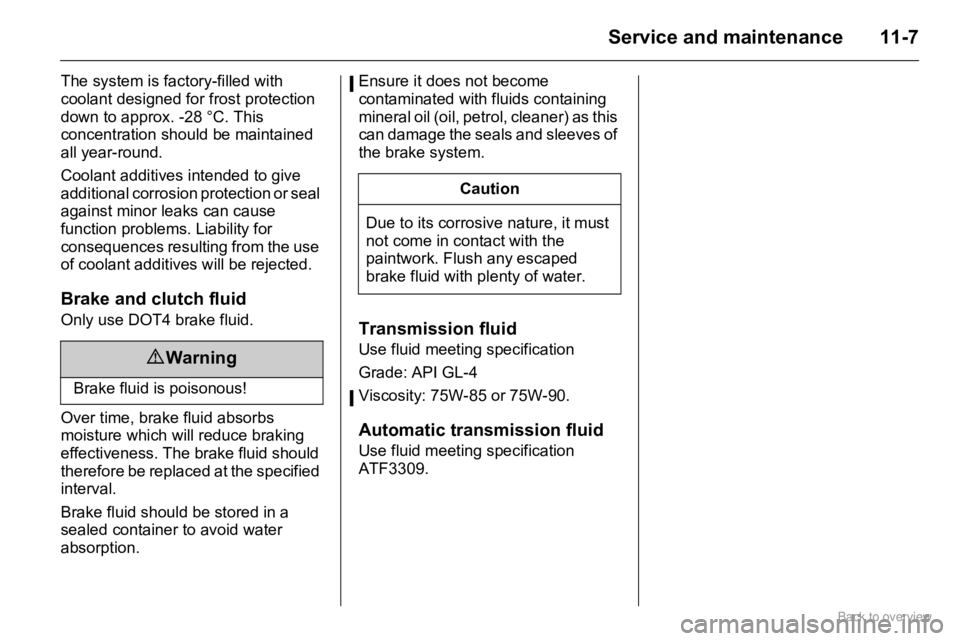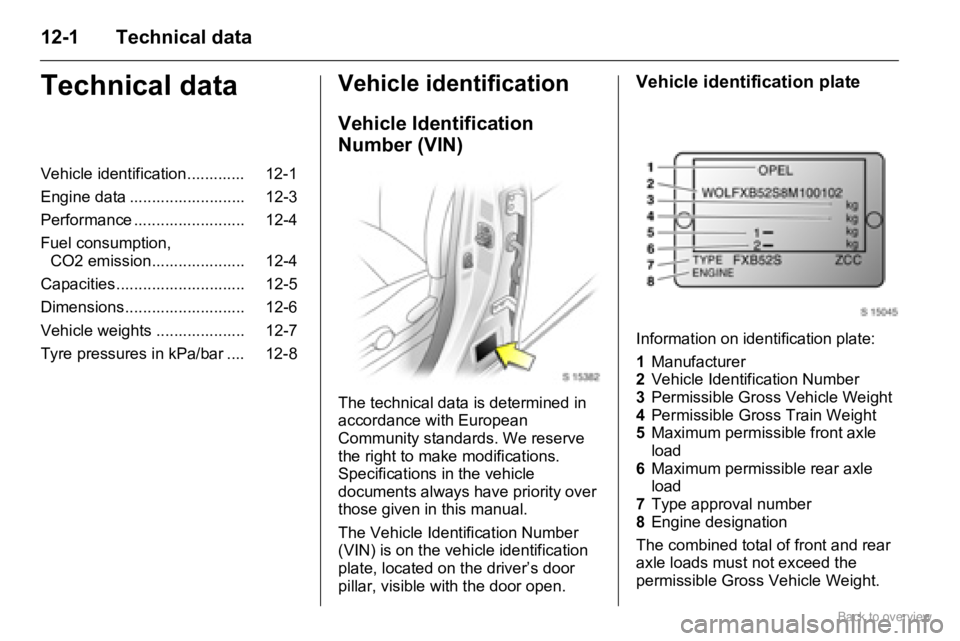OPEL AGILA 2009 Owners Manual
Manufacturer: OPEL, Model Year: 2009, Model line: AGILA, Model: OPEL AGILA 2009Pages: 153, PDF Size: 1.82 MB
Page 131 of 153

10-31Vehicle care
Polishing
Polishing is necessary only if the
paint has become dull or if solid
deposits have become attached to it.
Paintwork polish with silicone forms a
protective film, making waxing
unnecessary.
Plastic body parts should not be
treated with wax and polish.
Use Metallic Paintwork Wax on
vehicles with a metallic-effect paint
finish.
Plastic and rubber parts
For additional cleaning of plastic and
rubber parts, use a cleaner suitable
for vehicle interiors. Do not use any
other agent, and in particular do not
use solvents or petrol.
Windows and wiper blades
When cleaning the heated rear
window, make sure that the heating
element on the inside of the window
is not damaged. Never place stickers
on the inside of the rear window.Use a soft, lint-free cloth or chamois
leather, in conjunction with Window
Cleaning Spray and Insect Remover.
Do not use sharp instruments or
abrasive cleaners.
Windscreen Wash Solvent is suitable
for de-icing windows.
For mechanical removal of ice, use a
commercially available sharp-edged
ice scraper. Press the scraper firmly
against the glass so that no dirt can
get under it and scratch the glass.
Wax, such as that used in car
washes, can cause streaks to form on
the windscreen when the wipers are
used.
Wiper blades can be cleaned with a
soft cloth and Windscreen Wash
Solvent. Do not use abrasive
cleaners.Tyres and wheels
Do not use high-pressure jet cleaners
on wheels and tyres.
Use a pH-neutral wheel cleaning
agent to clean the wheels.Avoid using abrasive materials and
brushes that can damage the finish.
Wheels are painted and can be
treated with the same agents as the
body. For alloy wheels 3, we
recommend the use of Alloy Wheel
Preserver.
Paint damage
Repair small areas of paint damage
such as stone impacts, scratches etc.
before rust can form. If rust has
already formed, have the cause
remedied. Seek the assistance of a
workshop.
Underbody
Your vehicle has a factory-applied
PVC undercoating in the wheel
arches (including the longitudinal
members) which provides permanent
protection and needs no special
maintenance. The surfaces of the
vehicle underbody not covered by
PVC are provided with a durable
protective wax coating in critical
areas.
Page 132 of 153

10-32 Vehicle care
On vehicles which are washed
frequently in automatic car washes
with underbody washing facility, the
protective wax coating may be
impaired by dirt-dissolving additives.
Check the underbody after washing
and have it waxed if necessary.
Before the start of the cold weather
season, check the PVC coating and
protective wax coating and, if
necessary, have them restored to
perfect condition.
The underbody should be washed
following the end of the cold weather
season to remove any dirt adhering to
the underbody since this may also
contain salt. Check protective wax
coating and, if necessary, have it
restored to perfect condition.
Engine compartment
Areas of the engine compartment that
are painted in the same colour as the
vehicle must be looked after like any
other painted surface.
It is advisable to wash the engine
compartment before and after winter
and preserve it with wax. Cover alternator and fluid reservoirs with
plastic sheets before washing the
engine.
When washing the engine with a
steam-jet cleaner, do not direct the
steam-jet at components of the
Anti-lock Brake System (ABS), the air
conditioning system 3 or the belt
drive and its components.
Protective wax that has been applied
is also removed during the engine
wash. For this reason, have the
engine, brake system components in
the engine compartment, axle
components with steering, body parts
and cavities thoroughly preserved
with protective wax after the wash.
An engine wash can be performed in
the spring in order to remove dirt that
has adhered to the engine
compartment, which may also have a
high salt content. Check protective
wax layer and make good if
necessary.
Page 133 of 153

11-1Service and maintenance
Service and
maintenanceScheduled
maintenance
Service intervals
Interim Service
Due every 15,000 km (10,000 miles)
or 1 year, whichever occurs first.
Main Service
Due every 30,000 km (20,000 miles)
or 2 years, whichever occurs first.
The service intervals are based on
average operating conditions. For
severe operating conditions 311-5.
Service interval display 35-14.
Engine oil life monitor 35-14.Confirmations
Confirmation of Service is recorded in
the spaces provided in the Service
and Warranty Booklet. The date and
kilometre/mileage reading is
completed with the stamp and
signature of the Servicing Workshop.
Make sure that the Service and
Warranty Booklet is completed
correctly as continuous proof of
service is essential if any warranty or
goodwill claims are to be met, and is
also a benefit when you come to sell
the vehicle. Scheduled maintenance ....... 11-1
Service schedule .................. 11-2
Additional servicing ............... 11-5
Recommended fluids and
lubricants ............................ 11-5
Page 134 of 153

11-2 Service and maintenance
Service schedule
⊕Additional operations.o Under extreme operating conditions and if required by country-specific conditions, the intervals are reduced.
Service operations by year 1)
km ( x 1000)1)
miles ( x 1000)1)
1)Whichever occurs first.
1
15
102
30
203
45
304
60
405
75
506
90
60
Controls, lighting, signalling equipment and airbags: visual checkxxxxxx
Remote control batteries: replace every 2 years
Windscreen wipers, windscreen washer system: check, correctxxxxxx
Coolant level and antifreeze: check, correct
Hoses: check for tightness and secure seatingxxxxxx
Coolant: change every 3 years/45,000 km/30,000 miles
Brake fluid level: check, correct x x x
Battery terminals: check for secure connections and battery eyexxxxxx
Pollen filter: replace x x x
oMore often for when dust, sand or pollen is in the air agreement with customer
oAir cleaner element: inspect - petrol engines only xxxxxx
Air cleaner element: replace - petrol and diesel engines x x
⊕Spark plugs: replace every 7 years/105,000 km/70,000 miles
Page 135 of 153

11-3 Service and maintenance
Service operations by year 1)
km ( x 1000)1)
miles ( x 1000)1)
1)Whichever occurs first.⊕Additional operations.o Under extreme operating conditions and if required by country-specific conditions, the intervals are reduced.
1
15
102
30
203
45
304
60
405
75
506
90
60
Ribbed V-belt: visual check - petrol engines only x x
⊕ Replace every 6 years/90,000 km/60,000 miles
Ribbed V-belt and tensioner: visual check - diesel engines only x x x
⊕ Replace every 10 years/150,000 km/100,000 miles
⊕Valve clearances: check, adjust - petrol engines only x x x
Engine oil and oil filter: replace x x x x x x
oDiesel fuel filter: drain water x x x x x x
Diesel fuel filter: replace and bleed x x x
⊕Manual transmission: oil level check, correct x
Oil changexx
Parking brake cable: check, adjust x
Parking brake: check and adjust
Wheel mounting and suspension front and rear, brake lines, brake
pressure hoses, fuel lines, fuel tank and exhaust system: visual checkxxx
Corrosion protection: check and record in Service and Warranty Booklet annually
Front and rear wheel brakes: check visually x x x x x x
Page 136 of 153

11-4 Service and maintenance
⊕Additional operations.o Under extreme operating conditions and if required by country-specific conditions, the intervals are reduced.
Service operations by year 1)
km ( x 1000)1)
miles ( x 1000)1)
1
15
102
30
203
45
304
60
405
75
506
90
60
o⊕Automatic transmission fluid level: check correct x x x
Fluid hose: inspectx
Fluid: change every 165,000 km/110,000 miles
Engine, transmission, A/C compressor: check for leaks x x x x x x
oBrake drum: remove, clean, visual check x
Steering system boots, track rods, final drive: visual check x x
Track rod end and supporting ball joint: check x x x
⊕Brake and clutch fluid: change every 2 years
Wheel fastening: loosen and tighten to torque
Tyre condition and pressures: check, correctxxxxxx
First aid kit: visual check every 2 years
Headlamp aiming: check, adjust x x x
Door hinges, door stop, lock cylinder, lock striker, bonnet catch, tailgate
hinges and check links: lubricate xxx
Test drive, final check
Service interval display and oil life monitor: reset - if applicablexxxxxx
1)Whichever occurs first.
Page 137 of 153

11-5Service and maintenance
Additional servicing
Additional operations ⊕
Additional work is work that is not
required every service but can be
performed in conjunction with a
regular service.
Time allowances for such work are
not included in the scope of regular
services and will be charged for
additionally. It is more economic if
these operations are performed as
part of a scheduled service than
having them performed separately.
Severe operating conditions o
Operating conditions are classified as
severe when one or more of the
following occurs frequently:
�„cold starts,
�„stop and go,
�„trailer/caravan towing,
�„gradients and/or high altitudes,
�„poor road surfaces,
�„sand and dust,
�„extreme temperature fluctuations. Police vehicles, taxis and driving
school vehicles are also classified as
operating under severe conditions.
Under severe operating conditions, it
may be necessary to have certain
scheduled service work done more
frequently than the scheduled
intervals.
For example, if fuel is used that does
not comply with required standards,
the fuel filter may need more frequent
draining or replacement and it may
also be necessary to change other
components more often (e.g. spark
plugs).
It is recommended to seek technical
advice on the servicing requirements
dependent on the specific operating
conditions of your vehicle.
Recommended fluids
and lubricants
Only use products that have been
tested and approved. Damage
resulting from the use of non-
approved materials will not be
covered by the warranty.
Checking and topping up fluids
3 10-3.
9 Warning
Operating materials are
hazardous and must be handled
with the appropriate level of care.
If consumed, seek medical
attention immediately. Do not
inhale fumes and avoid skin
contact. Keep out of reach of
children. Do not allow operating
materials to contaminate the
sewage system, surface water,
ground water or soil. Dispose of
empty containers properly.
Always bear in mind that
operating materials are
hazardous to your health.
Page 138 of 153

11-6 Service and maintenance
Engine oil
Engine oil is identified by its quality
and also its viscosity. Quality is more
important than viscosity when
selecting which engine oil to use.
Engine oil quality
Opel engine oil meets classifications
GM-LL-A-025 and GM-LL-B-025 and
is therefore suitable for both petrol
and diesel engines.
Topping up engine oil
Oils of different manufacturers and
brands can be mixed as long as you
comply with the specified engine oil
criteria (quality and viscosity).Not every engine oil available on the
market meets the quality
requirements, always check the
required specification and rating is
marked on the container.
If engine oil of the required quality is
not available, a maximum of 1 litre of
ACEA A3/B4 or A3/B3 grade may be
used (only once between each oil
change). The viscosity should be of
the correct rating.
Use of ACEA A1/B1 and A5/B5
engine oil is expressly forbidden,
since they can cause long-term
engine damage under certain
operating conditions.
Engine oil additives
The use of engine oil additives could
cause damage and invalidate the
warranty.
Engine oil viscosity
Diesel engines:
SAE 0W-30, 0W-40, 5W-30 or 5W-40
Petrol engines:
SAE 5W-30The SAE viscosity rating defines the
ability of an oil to flow. When cold, oil
is more viscous than when hot.
Multigrade oil is indicated by two
figures. The first figure, followed by a
W, indicates low temperature
viscosity and the second figure the
high temperature viscosity.
Coolant and antifreeze
Use antifreeze of recommended
specification. GM-LL-A-025: Petrol engines
GM-LL-B-025: Diesel engines
GM General Motors Europe
LL Longlife
A or B Engine oil quality
specification
025 Validity index
Page 139 of 153

11-7Service and maintenance
The system is factory-filled with
coolant designed for frost protection
down to approx. -28 °C. This
concentration should be maintained
all year-round.
Coolant additives intended to give
additional corrosion protection or seal
against minor leaks can cause
function problems. Liability for
consequences resulting from the use
of coolant additives will be rejected.
Brake and clutch fluid
Only use DOT4 brake fluid.
Over time, brake fluid absorbs
moisture which will reduce braking
effectiveness. The brake fluid should
therefore be replaced at the specified
interval.
Brake fluid should be stored in a
sealed container to avoid water
absorption. Ensure it does not become
contaminated with fluids containing
mineral oil (oil, petrol, cleaner) as this
can damage the seals and sleeves of
the brake system.Transmission fluid
Use fluid meeting specification
Grade: API GL-4
Viscosity: 75W-85 or 75W-90.
Automatic transmission fluid
Use fluid meeting specification
ATF3309.
9 Warning
Brake fluid is poisonous!
Caution
Due to its corrosive nature, it must
not come in contact with the
paintwork. Flush any escaped
brake fluid with plenty of water.
Page 140 of 153

12-1 Technical data
Technical dataVehicle identification
Vehicle Identification
Number (VIN)
The technical data is determined in
accordance with European
Community standards. We reserve
the right to make modifications.
Specifications in the vehicle
documents always have priority over
those given in this manual.
The Vehicle Identification Number
(VIN) is on the vehicle identification
plate, located on the driver’s door
pillar, visible with the door open.
Vehicle identification plate
Information on identification plate:
1Manufacturer
2Vehicle Identification Number
3Permissible Gross Vehicle Weight
4Permissible Gross Train Weight
5Maximum permissible front axle
load
6Maximum permissible rear axle
load
7Type approval number
8Engine designation
The combined total of front and rear
axle loads must not exceed the
permissible Gross Vehicle Weight. Vehicle identification............. 12-1
Engine data .......................... 12-3
Performance ......................... 12-4
Fuel consumption,
CO2 emission..................... 12-4
Capacities............................. 12-5
Dimensions........................... 12-6
Vehicle weights .................... 12-7
Tyre pressures in kPa/bar .... 12-8